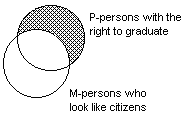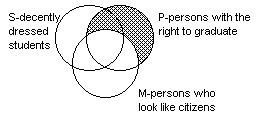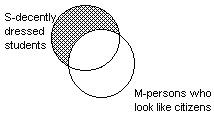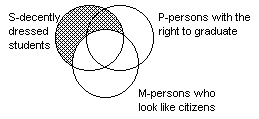|
|
|
Philosophy 103: Introduction to Logic
Syllogistic Terminology, Part I |
 |
|
|
Abstract:
Today's class introduces the logical terms used to describe two-premiss
arguments composed of categorical statements. As a stalking horse, we analyze two
arguments and test them for validity by means of Venn Diagrams.
The Notes to Syllogistic Terminology are in two parts:
Part I: Introduction of the Terms of the
Syllogism
Part II: Review and Practice with
Syllogistic Terminology
Part I: Introduction of the Terms of the
Syllogism
Let us evaluate the following
argument offered by Councilman William Meyers: "University students should have the
right to graduate, if they dress decently. When you accept the responsibility of
graduation into our society, you should look like a citizen."
As we analyze Councilman Meyers' argument, we will introduce the
nomenclature of syllogistic arguments.
In order to evaluate this casual argument with charity, we need to be able to
translate the argument reliably into standard-form categorical propositions.
- The first step is to find the conclusion:
"University students should have the right to graduate, if they dress decently."
- The conclusion has the form: p if q, where p and
q stand for different statements. Such conditional
statements are often best handled with symbolic logic, but here we want to
analyze the argument in terms of categorical form.
- Let's step back and see what "p if q" means. Suppose p
stands for "the bird is black" and q stands for "the bird is a raven."
Our statement form, "p if q," in this case, would be, "The bird is
black, if it is a raven." In standard categorical form, we could translate, "All
ravens are black."
- Using this model, we can translate Meyers' conclusion as "All decently
dressed persons are persons with the right to graduate."
- The subject of the conclusion is called the minor term of the
syllogism: "decently dressed students."
- The predicate of the conclusion is called the major term of the
syllogism: "persons with the right to graduate."
- The second step is to find the premisses
and put the syllogism into standard order and
form.
- Standard form indicates that all the statements are standard-form
categorical propositions (A, E, I, or O).
- Standard order indicates that the statements are put in
the sequence of the major
premiss first, the minor premiss second, and the conclusion third.
Thus, to find the standard order of a syllogism, we need to first find out what the major and minor premiss are.
- Not surprisingly, the major premiss is the premiss containing the
major term. The major premiss is conventionally labeled with the letter 'P."
- Likewise, the minor premiss is the premiss containing the minor term.
The minor term is labeled by convention with the letter "S."
- Mr. Meyers gives only one premiss: "When you accept the responsibility of
graduation, you should look like a citizen."
- The first part of the premiss, "When you accept the responsibility of
graduation..." is meant to represent the same class as "persons with the right to
graduate."
- Since "persons who have the right to graduate" is the predicate term of Mr.
Meyers' conclusion, this premiss is our major premiss.
- We can now translate the premiss to read in categorical form: "All persons
with the right to graduate are persons who look like citizens."
- Mr. Meyers' argument can now be put as follows:
All persons with the right to graduate are persons who look like citizens.
....{no minor premiss present
yet}....
___________________________________
All decently dressed people are persons with the right to graduate.
- Since, his premiss contains the major term, it is called the major premiss and
is put first in the argument.
- Mr. Meyers is assuming his listeners will supply the missing premiss. When
an argument is elliptical in this manner (i.e., with a missing
statement), the argument
is called an enthymematic
argument.
- The missing premiss is the minor premiss and thus contains the minor term,
"decently dressed students."
- So the only statement which makes sense as the minor premiss is the
statement, "all decently dressed students are persons who look like
citizens."
(By the
principle of charity, we suppose Mr. Meyers is assuming the most reasonable
premiss.)
- The term occurring in both premisses, but not in the conclusion is called the
middle term and is symbolized by the letter "M."
- The categorical syllogism can now be put as follows.
| |
P--MAJOR
TERM |
|
M--MIDDLE
TERM |
| All |
[persons with the right to graduate] |
are |
[persons who look like citizens]. |
| |
S--MINOR
TERM |
|
M--MIDDLE
TERM |
| All |
[decently dressed students] |
are |
[persons who look like
citizens]. |
|
| |
S--MINOR
TERM |
|
P--MAJOR
TERM |
| All |
[decently dressed students] |
are |
[persons with the right to graduate]. |
- The form of the syllogism can be conveniently put as
All P is M.
All S is M.
All S is P.
- Two more terms are worth noting in our analysis of this syllogism. Logicians
call the order of the names of the statements the mood of the syllogism.
Mr. Meyers' syllogism is an AAA syllogism. Note that the mood does not
uniquely describe the form of the syllogism, even though, by convention, the
conclusion has the S and P term and the premisses contain the
M term.
- figure In other words, if all we knew about
Mr. Meyers' syllogism was that it was an AAA syllogism, we can
conceive of the following possibilities for the position of the middle
term.
| Figure
1 |
|
Figure
2 |
|
Figure
3 |
|
Figure
4 |
| **M
-- P |
|
**P
-- M |
|
**M--
P |
|
**P
-- M |
| **S
-- M |
|
**S
-- M |
|
**M--
S |
|
**M
-- S |
| **S
-- P |
|
**S
-- P |
|
**S
-- P |
|
**S
-- P |
- The position of the middle term is described by the figure of the
syllogism. The figures are named "1," "2," "3," and
"4." They are easily remembered because they form the shape of a flying
brick.

Think of the M's being solid in the center with no other terms
between them. Mr. Meyer's syllogism is an AAA-2 syllogism since the
M
term is in the predicate of both premisses.
- The mood and figure uniquely describe the form of the syllogism.
Any syllogism of this form will have the same degree of validity or invalidity.
I.e., if Mr. Meyer's AAA-2 syllogism is invalid, then any other syllogism
of the same form is invalid.
- The third step is to test the syllogism by
means of Venn Diagrams or the rules for validity. This might be a good time to
review the symbols used to diagram the
standard-form propositions.
- The idea is to look at the logical geography of the premisses. If the argument
is valid, the premisses should mark out the conclusion beyond doubt, without
further markings.
- . The major premiss, "All P is M" would be diagrammed as the
picture below. The diagram has been slanted so that it can be superimposed on
the diagram for all three classes later.
- The minor premiss, "All S is M" would be diagrammed as the picture
below. It also has been slanted so it can be superimposed in the diagram above.
- Putting both diagrams together on
the representation of the S, P, and M classes would give a picture
like the one below. Can we "read off" the conclusion without further markings?
Is there any possibility of an S not being a P? Do diagramming the premisses
without additional marking produce a diagram of the conclusion?
- Since there is the possibility of an "S" being in the area
marked, and it is outside of the P-area, the syllogism is invalid. Mr.
William Meyer's syllogism is invalid. He might have a false premiss as well.
Continue with
Part II: Review and Practice with
Syllogistic Terminology
Check your understanding
with a Quiz on Syllogistic Terminology

|
|







